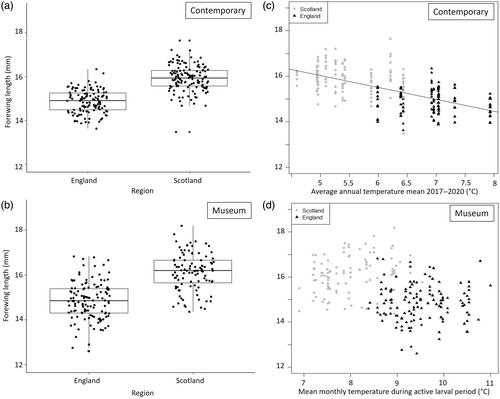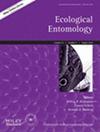山地蝴蝶在其温暖分布区边界的体型缩小
IF 1.6
3区 农林科学
Q2 ENTOMOLOGY
引用次数: 0
摘要
昆虫体型的变化通常与发育过程中的温度有关,如果较小个体的适应性降低,可能会影响种群在未来气候变暖条件下的持续生存。因此,我们研究了英国蝴蝶 Erebia epiphron(鳞翅目:蛱蝶科)体型的时空变化。我们研究了体型与温度相关的时空变化。2018年至2019年期间,我们在英格兰和苏格兰海拔380米至720米的地区采集了19个种群样本(每个种群6-15只),并研究了1890年至1980年间采集的博物馆标本。我们研究了个体体型(前翅长度)及其与地点当地温度的关系,以及上个世纪体型与幼虫发育期间温度的时间变化关系。英格兰野外采集的个体前翅长度比苏格兰平均小7%-8%(英格兰平均=14.9毫米,苏格兰平均=15.9毫米),温度较高的地点个体也较小(当地平均温度每升高1°C,翅长减少0.13毫米)。然而,我们没有发现幼虫发育过程中温度的时间变化对体型变化的影响。在英国种群中观察到的较小体型可能会对繁殖力和扩散能力产生影响。未来的工作应寻求了解这两个种群的生命周期长度、遗传学和表型可塑性,以评估区域差异的潜在解释。本文章由计算机程序翻译,如有差异,请以英文原文为准。


Reduced size in a montane butterfly at its warm range boundaries
求助全文
通过发布文献求助,成功后即可免费获取论文全文。
去求助
来源期刊

Ecological Entomology
生物-昆虫学
CiteScore
4.90
自引率
4.50%
发文量
94
审稿时长
3 months
期刊介绍:
Ecological Entomology publishes top-quality original research on the ecology of insects and related invertebrate taxa. Our aim is to publish papers that will be of considerable interest to the wide community of ecologists who are motivated by ecological or evolutionary theory. The suitability of a manuscript will usually be assessed within 5 days.
We publish full-length Original Articles as well as Reviews, Short Communications, Methods and Natural History papers. In Original Articles, we greatly prefer papers that test specific hypotheses and which have a high degree of novelty. All categories aim for innovative contributions that advance the subject of ecological entomology.
 求助内容:
求助内容: 应助结果提醒方式:
应助结果提醒方式:


